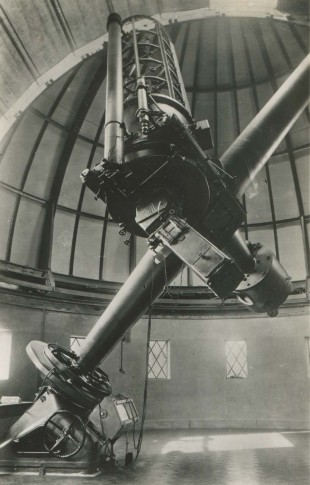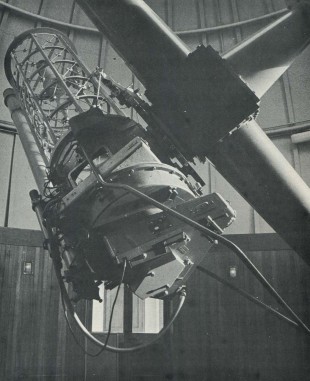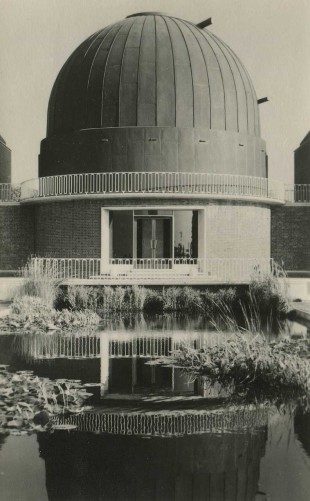…where east meets west
- Home
- Brief History
- The Greenwich Meridian
- Greenwich
(1675–1958) - Herstmonceux
(1948–1990) - Cambridge
(1990–1998) - Outstations (1822–1971)…
- – Chingford (1822–1924)
- – Deal
(1864–1927) - – Abinger
(1923–1957) - – Bristol & Bradford on Avon
(1939–1948) - – Bath
(1939–1949) - – Hartland
(1955–1967) - – Cape of Good Hope
(1959–1971)
- Administration…
- – Funding
- – Governance
- – Inventories
- – Pay
- – Regulations
- – Royal Warrants
- Contemporary Accounts
- People
- Publications
- Science
- Technology
- Telescopes
- Chronometers
- Clocks & Time
- Board of Longitude
- Libraries & Archives
- Visit
- Search
Telescope: The Yapp 36-inch Reflector

The Yapp telescope in about 1934 with the slitless spectroscope attached. From a postcard published by the Royal Observatory, Greenwich

A rare view of the telescope with both the north and south piers visible. From 36 in. Reflecting Telescope of the Royal Observatory, Greenwich (Reprinted from The Engineer, 18 & 25 May, 1934). Sir Howard Grubb, Parsons and Company, Publication No.11 (1934).
Mothballed during the Second World War, the telescope was brought back into use at Greenwich in 1946. It was dismantled at the end of 1955 and later taken to Herstmonceux where it was eventually re-erected in dome B and brought back into use in August 1958. The telescope is still at Herstmonceux and is currently in the care of the The Observatory Science Centre.

The telescope at the Grubb Parsons Optical Works. From Astronomical and Optical Instruments, Sir Howard Grubb, Parsons & Company Publication No. 9 (1934)

The telescope at Greenwich, but this time with an eye-piece for visual observing. From Astronomical and Optical Instruments, Sir Howard Grubb, Parsons & Company Publication No. 9 (1934)
Spencer Jones’s description of the insturment
Brief details of the telescopes construction were published by Spencer Jones in his 1934 Report to the Board of Visitors:
‘The mounting of the telescope is of the modified English form, that is the long polar axis is supported by piers at the north and south ends, the crosshead carrying the telescope being attached to the middle of the axis. The polar axis is long enough to permit of reversal under the axis. The telescope consists of a central heavy casting to which is attached, on the one side, the mirror cell, and on the other, the open work tube. The instrument can be turned by electric motors in either co-ordinate, quick and slow setting motions, in addition to guiding motions, being provided. The driving mechanism is of the Grubb pattern and incorporates important recent improvements by the makers.
The telescope is designed for use in Cassegrain form. The 36-inch mirror is made of glass and is of 15 feet focal length. Two alternative secondary convex mirrors, made of fused quartz, are provided. The larger of these is of 11 inches diameter and 75¾ inches focal length. It is set 50½ inches inside the principal focus, giving an equivalent focal length of 45 feet. In this form it will be used with a slit spectrograph. The smaller convex mirror, of 7 inches aperture and 30 inches focal length, is set 30 inches inside the principal focus of the 36-inch mirror. It thus returns a parallel beam 6 inches in diameter which is fed into a slitless spectrograph.
The slitless spectrograph has been constructed by Messrs. Adam Hilger, Limited. Its construction is similar in principle to that which was made in the Observatory workshop some years ago and mounted on the 30-inch reflector. As a result of the experience gained the present spectrograph has been improved in detail. The 6-inch parallel beam from the telescope passes through a prism of 45° angle. The dispersed beam then falls on a 9-inch concave mirror of 36 inches focus and after reflection from a diagonal flat, the spectrum focusses on the photographic plate which is situated at the side of the spectrograph. The spectrum is broadened by an automatic device, the plate holder being moved by an electric motor and cam. Three cams are provided giving broadenings of ⅓ mm., ½ mm. and 1 mm.
The working tests of the new telescope have shown a highly satisfactory performance. In conjunction with the slitless spectrograph, work has been commenced on a programme of observations of the colour temperatures of stars, in continuation of the work which has been carried on under difficulties with the 30-inch reflector mounted on the Thompson Equatorial. The light grasp of the combination of telescope and spectrograph is very satisfactory. For a star of magnitude 3.0, a well-exposed spectrum is obtained with an exposure time of three minutes.
Plans for the construction of a slit spectrograph have been prepared; The spectrograph will have two prism systems, viz., one prism and three prisms. All the optical parts will be constructed of ultra-violet glass.’
Details of the slit spectrograph were given in the 1935 Report:
‘A contract has been placed with Messrs. Adam Hilger, Ltd., for the construction of a slit spectrograph which will be mounted on the Yapp 36-inch reflecting telescope. This spectrograph will have two prism systems, viz., one prism and three prisms. The optical parts will be constructed of ultra-violet glass giving good transmission down to λ 3500. The design includes provision for half-aperture shutters across the collimator for the purposes of the Hartmann focal test. A further pair of half-aperture shutters will provide an accurate means of checking photometric scales. The instrument will be fitted with a Cambridge automatic temperature regulator.’
The spectrograph was delivered to the Observatory on 8 April 1937.

The dome at Greenwich before the telescope was installed. The entry steps are on the east side of the building. Above the door, the year 1932 is carved into the stonework. Soon after the picture was taken, the words The gift of William Johnston Yapp were carved beneath it. From Astronomical and Optical Instruments, Sir Howard Grubb, Parsons & Company Publication No. 9 (1934)

Sectional view though the dome and piers. From 36 in. Reflecting Telescope of the Royal Observatory, Greenwich (Reprinted from The Engineer, 18 & 25 May, 1934). Sir Howard Grubb, Parsons and Company, Publication No.11 (1934).
Location of the telescope at Greenwich
As there was no space on the main site, the telescope was set up on the west side of the Christie Enclosure, a few hundred metres to the east across the Park. The building was designed by the Admiralty’s Civil Engineer-in-Chief, in accordance with the requirements of the Astronomer Royal and of the contractors for the instruments. It was built by the Civil Engineer’s Department. The building and dome were completed in late 1932. The telescope was installed later with the help of a block and tackle. Described by Charles Davidson in 1934 as being constructed from ‘a pleasing red brick’, the building had two floors. The observing room was at first floor level and entered directly from the east side via an external flight of steps. Below it at ground floor level there was a store and lavatory. The building also contained a silvering room in a small wing located on the north side of the building at right angles to the entrance.
Click here to read more about the building.
The telescope at Herstmonceux
Towards the end of 1955, the telescope was taken out of use at Greenwich so that it could be reconditioned prior to being re-ercted at Herstmonceux. Dismantling started on 21 November and by 5 January, only the stripped polar axis was left between the piers. Towards the end of 1956, the main mirror was sent to the Newcastle works of Sir Howard Grubb, Parsons and Company for refiguring to remove defects that had been discovered during testing by Cox, Hargreaves & Thompson during the winter of 1954/5. The rest of the telescope was taken to Herstmonceux where it had arrived by 3 December ready for erection in Dome B.

The Equatorial Group in about 1959. Dome B containing the Yapp Telescope is the fourth dome from the left. From an old (RGO?) postcard

The telescope with the new Cassegrain Spectrograph attached. From Royal Observatory Bulletins, Number 118 (1966)
Re-erection of the heavy parts was completed during March 1958 and the telescope was brought back into use in August. Initially it was used with the original spectrographs, but in the early 1960s a new cassegrain spectrograph was fitted. The product of the combined efforts of the Engineering, Electronics and Astrophysics departments at Herstmonceux, it was brought into regular use in early 1963. The telescope was also used as a test bed for equipment developed for use elsewhere, particularly the Isaac Newton telescope, which came into use in 1967. For this purpose, its secondary mirror mounting was modified in the 1970s.
Further Reading
36 in. Reflecting Telescope of the Royal Observatory, Greenwich (Reprinted from The Engineer, 18 & 25 May, 1934). Sir Howard Grubb, Parsons and Company, Publication No.11 (1934).
A seventeen page article with six photographs and numerous diagrams.
The Yapp reflector of the Royal Observatory, Greenwich. Charles Davidson. The Observatory, Vol. 57, pp.159–163 (1934). For accompanying image click here.
The opening of the Yapp telescope at Greenwich. The Observatory, Vol. 57, pp.218–223 (1934). For accompanying image click here.
Silvering Methods at Greenwich 1900–1956. E.G. Martin. The Observatory, Vol. 84, p. 20-23 (1964)
The cassegrain spectrograph of the Yapp 36-inch Reflector at Herstmonceux. JD Pope, DR Palmer and JB Alexander. Royal Observatory Bulletins, Number 118, HMSO (1996)
© 2014 – 2025 Graham Dolan
Except where indicated, all text and images are the copyright of Graham Dolan

